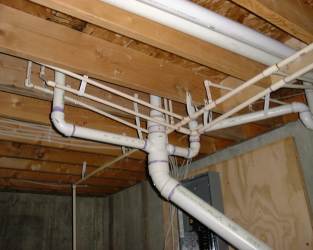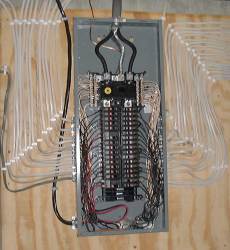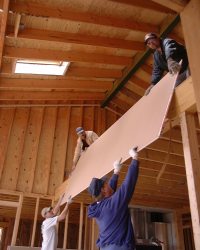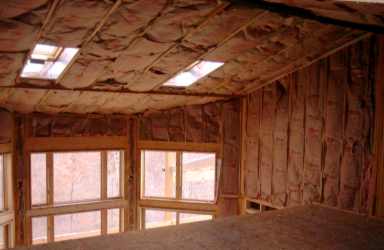
Unless you build a house you probably haven't thought much about all the systems that are buried in the walls and floors.
Water requires hot and cold supply lines to bring it in and waste, drain and vent lines to get rid of it. The kitchen, bathrooms, and laundry are obvious, but you also will want drains for the utility room, storm cellar and hot tub. The water heater requires a gas supply and vent for combustion gases. The heating system includes the furnace of course, with its hot air supply ducts and registers; cold air returns; thermostat, wiring, and controls; gas supply; and combustion air and exhaust. The gas also must be connected from the regulator on the outside tank to the regulator on the house and from there to the water heater, furnace, a backup heater in the family room (it will work without electric power) and to where the kitchen stove is to be installed. Fans in each of the bathrooms need to be vented outside as does the vent for the stove hood. Electrical connections go from the meter base to the service panel and then throughout the house. When these are put in make sure that you have the right size wire, the boxes are at least the size required by code for the number and size of wires and devices in them, ground fault circuit interrupters (GFCIs) are in all the right places, that the outlets over the kitchen counter are on at least 2 separate circuits, that the power for the dishwasher and stove hood are positioned behind each of them, no circuit has more than 10 receptacles, and there are sufficient power outlets for computers, TV and audio systems where you will want them. Put switches for lighting near all the doors, some of these will be 3 way or 4 way so that you can turn on the lights no matter which way you come into the room. Put telephone connections in every room, two places in some rooms because you may want to rearrange the furniture and so you will need the phone to be on another wall and putting it there will be difficult after the sheetrock is in place. Video connections (satellite and broadcast) will be needed in several places but put them in a lot more, just like the phones. The rooftop antennas require separate leads to their distribution amplifiers. While you are at it put computer connections all over the place as well. Cat 5 is our guess for what will be useful for later expansion. Distribute audio signals throughout the house so that the same music can be heard wherever you are without cranking up the volume at the source. The wood stove and fireplace each require separate double or triple wall vent stacks. A chase carries these and the water heater vent to the roof (be sure to observe minimum clearances to combustible material) where a properly ventilated but weather tight cap closes the top of the chimney. Also put conduit leading to the space over the ceilings and to the roof so that any future connections that may be required can be made more easily. While it is not an active system the insulation (walls R 24, ceiling R 30) is an essential part of the infrastructure. Of course there are smoke detectors to be scattered around the house and an intrusion detection system. Since two of the skylights are about 18 feet above the living room floor install power openers for them. These require low voltage wiring to each of the units and to a rain sensor on the roof. The central vacuum system has 7 ports for connection of the vacuum hose and a VacPan to get rid of crumbs from the kitchen floor. From each port and the VacPan there is a pipe (straight and direct, please) connecting to the dust bin and power unit. Air from the unit must to be vented outside. The control for the vacuum is another set of low voltage wires that signal the power unit to turn on when a port is to be used. While hardly required for most folks, it is interesting to keep track of the temperature, humidity, barometric pressure, wind speed, and direction so install a weather station which logs data every 15 minutes on the computer. Most of this is hidden from view but each part requires learning another set of codes, rules, skills, etc. so that it will pass inspection, and/or be safe, and/or work.
So that, Dear Friends, is how the Kountry Kuehners have spent much of the first year of our retirement.

After several frustrating months the plumbing was finished and had passed inspection. If you build a house hire the plumbing done. We would buy the plumbing parts by the bushel and still have to go back and buy more. Then we started the pressure test. We would find a small leak and reglue that section and pressure test again, just to find another leak. This went on for weeks. The test caps would crack from having the air pressure run up and down multiple times. Finally, we resorted to caulk, duct tape and concrete blocks to seal the temporary plugs on the day of the inspection. It was really good to have that job complete. Now, let's hope all the joints are sound when we turn on the water. They should be, that part of the plumbing held 70 pounds of air pressure. The water supply lines were much easier to connect than the waste lines.

The electrical wiring was rather fun and quite easy as long as we kept good track of where the wires were going. We used 2,500' of wire for outlets and switches. There was that much more for computer, telephone, video and audio wiring. Alan will install the switches and outlets and cover plates. As soon as that is complete we will be able to get the permanent electric hook up. It will be very nice to have outlets that work in every room instead of many extension cords.

A crew of four guys from A&D in Ashland delivered and distributed the 220 sheets of 4'x12' sheetrock in each of the rooms. Here the crew is lifting the sheetrock over the front edge of the loft. Hiring this job done was great. It took this crew 4 hours to unload the trucks and we were really glad all the sheetrock was being carried by someone else.

Doing the insulation took 2 days and wasn't as tough a job as anticipated. The tyvek suits we wore were very effective at keeping us mostly itch free. The pink insulation is much nicer to work with than some yellow stuff we used on one of the walls in the basement. We used R-30 in the ceilings and R-24 in the walls, so we hope the house will be comfortable in winter and summer. This is the view from our loft looking south through the front windows of the living room, nothing but woods in this view.
Go to our Science Fun pageE-mail Nancy
and
Alan